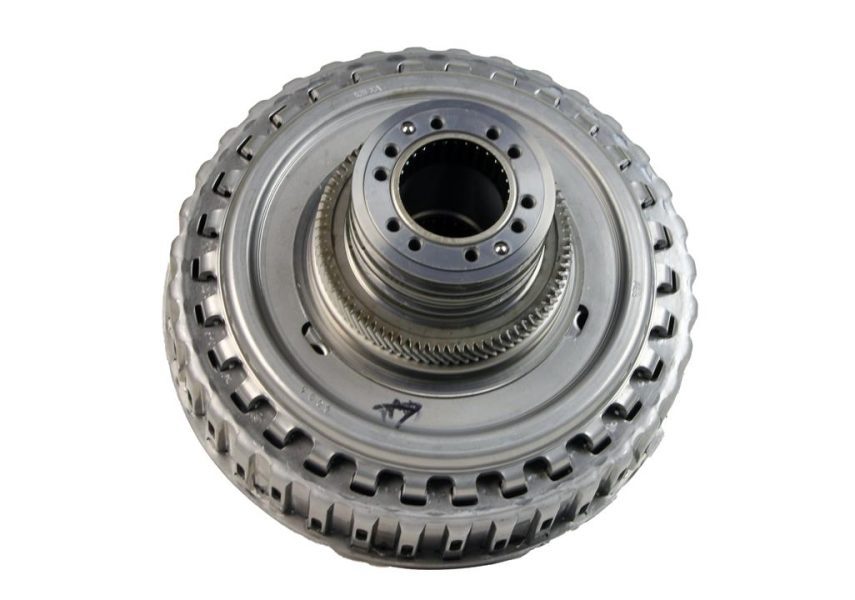
The device and principle of operation of the multi-plate friction clutch
Content
In the description of the technical characteristics of many SUVs and some passenger cars with different modifications of the four-wheel drive transmission, you can often find the concept of a multi-plate clutch. This friction element is part of the so-called plug-in all-wheel drive. The operation of this element makes it possible, if necessary, to make an inactive axis the leading one. This design is used, for example, in the xDrive system, about which there is A separate article.
In addition to cars, multi-plate clutches are successfully used in various mechanical devices in which power take-off occurs between two different mechanisms. This device is installed as a transition element, leveling and synchronizing the drives of the two mechanisms.
Consider the principle of operation of this device, what are the varieties, as well as their pros and cons.
How the clutch works
Multi-plate friction clutches are devices that allow the driven mechanism to take off power from the master. Its design includes a pack of discs (friction and steel types of parts are used). The action of the mechanism is provided by compressing the discs. Often in cars, this type of clutch is used as an alternative to a locking differential (this mechanism is described in detail in another review). In this case, it is installed in the transfer case (about what it is and why it is needed in the transmission, read here) and connects the driven shaft of the second axle, due to which the torque is transmitted to the inactive wheels, and the transmission begins to turn them. But in a simpler version, such a device is used in the clutch basket.
The main task of these mechanisms is to connect / disconnect two running units. In the process of connecting the drive and driven discs, the clutch occurs smoothly with a progressive increase in power in the drive unit. On the contrary, safety clutches disconnect the devices when the torque exceeds the maximum permissible value. Such mechanisms can independently connect the units after the peak load has been eliminated. Due to the low accuracy of this type of couplings, they are used in mechanisms in which often, but for a short period of time, decent overloads are formed.
To understand the principle of operation of this mechanism, it is enough to remember how the clutch of the gearbox (mechanic or robot), or the clutch basket, functions. Details about this unit of the car are described separately... In short, a powerful spring presses the disc against the flywheel surface. Thanks to this, power is taken from the power unit to the input shaft of the gearbox. This mechanism is used to temporarily disconnect the transmission from the internal combustion engine, and the driver was able to shift into the desired gear.
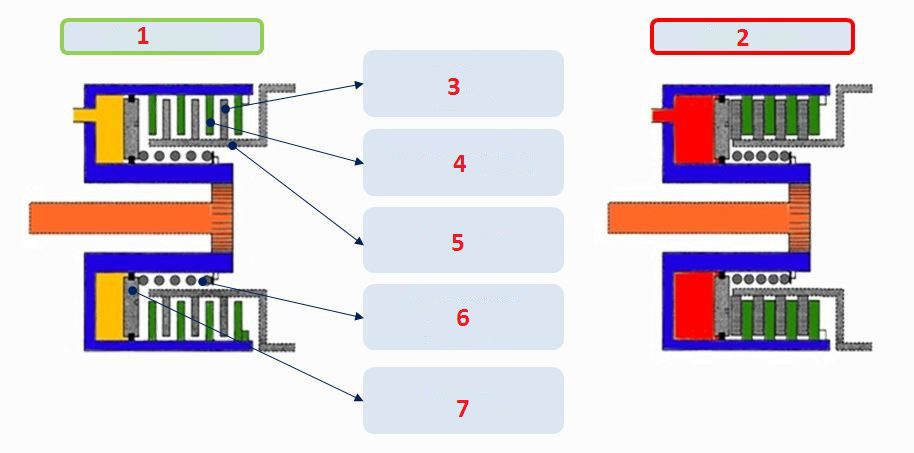
The main difference between a multi-plate clutch and a locking differential is that the mechanism under consideration provides a smooth connection of the drive and driven shafts. The action is carried out by the friction force, which provides strong adhesion between the discs and power is taken off to the driven unit. Depending on the device that compresses the discs, the pressure on them can be provided by a powerful spring, an electric servo or a hydraulic mechanism.
The torque coefficient is directly proportional to the compression force of the discs. When the transfer of power to the driven shaft begins (each disc is gradually pressed against each other, and the clutch begins to twist the driven shaft), friction between the actuators provides a smooth increase in the force acting on the secondary mechanism shaft. Acceleration is smooth.
Also, the torque force depends on the number of discs in the clutch. The multi-disc view has a greater efficiency in transferring power to the secondary node, since the contact surface of the contacting elements increases.
For the device to work correctly, it is necessary to maintain a gap between the surfaces of the discs. This parameter is set by the manufacturer, as engineers calculate the forces that need to be applied in order for the mechanism to effectively transmit torque. If the disc clearance is less than the specified parameter, the drive disc will rotate the driven elements as well, without the need for them to work.
Because of this, the coating of the discs wears out faster (how quickly depends on the size of the gap). But the increased distance between the discs will inevitably lead to premature wear of the device. The reason is that the discs will not be pressed with as much force, and as the rotational power increases, the clutch will slip. The basis for the correct operation of the coupling after its repair is to set the correct distance between the contact surfaces of the parts.
Device and main components
So, the clutch consists of a steel structure. There are several friction discs in it (the number of these elements depends on the modification of the mechanism, as well as the strength of the moment that it must transmit). Steel counterparts are installed between these discs.
Friction elements are in contact with smooth steel analogs (in some cases, all contact parts have a corresponding spraying), and the friction force provided by the coating material (it is permissible to use ceramics, as in ceramic brakes, Kevlar, composite carbon materials and so on), allows you to transfer the necessary forces between the mechanisms.

The most common modification of such a modification of discs is steel, on which a special coating is applied. Less common are similar options, but made of high-strength plastic. One group of discs is fixed to the hub of the drive shaft, and the other to the driven shaft. Smooth steel discs without a friction layer are fixed to the driven shaft drum.
A piston and a return spring are used to press the discs tightly against each other. The piston moves under the action of the drive pressure (hydraulics or electric motor). In the hydraulic version, after the pressure in the system decreases, the spring returns the discs to their place, and the torque stops flowing.
Among all varieties of multi-plate clutches, there are two types:
- Dry... In this case, the discs in the drum have a dry surface, due to which the maximum coefficient of friction between the parts is achieved;
- Wet... These modifications use a small amount of oil. Lubricant is necessary in order to improve the cooling of the discs and lubricate the mechanism parts. In this case, a significant decrease in the coefficient of friction will be observed. To compensate for this disadvantage, the engineers provided a more powerful drive for such a clutch, which presses the discs more strongly. Additionally, the friction layer of the parts will include modern and efficient materials.
There is a wide variety of disc friction clutches, but the principle of operation is the same for all of them: the friction disc is strongly pressed against the surface of the steel analogue, due to which the coaxial shafts of different units and mechanisms are connected / disconnected.
Materials used in construction
Traditionally, a steel disc is made from high-alloy steel, which is coated with an anti-corrosion agent. In modern vehicles, an option made from carbon composite materials or Kevlar may be used. But the most effective today are conventional friction options.
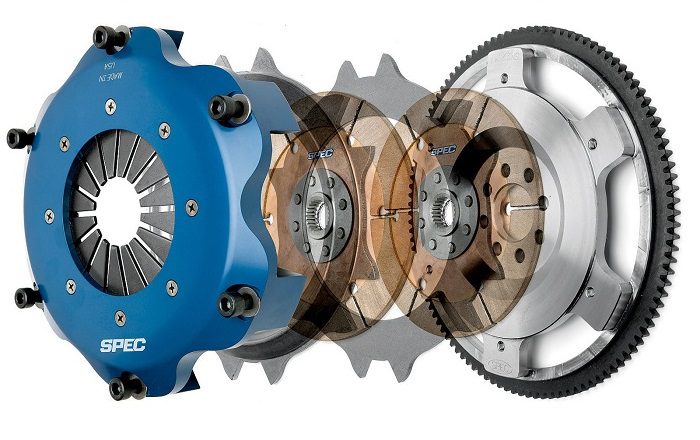
Manufacturers use different components to make such products, but most often these are:
- Retinax... The composition of such material includes barite, asbestos, phenol-formaldehyde resins and brass shavings;
- Tribonite... This material is made from a mixture of some petroleum products and composite substances. Such products are more resistant to oxidative reactions, so that the device can be used in high humidity conditions;
- Pressed composite... In addition to the key components that ensure product integrity, this material contains high strength fibers that increase the life of the product, preventing premature wear.
Part release form
As mentioned earlier, a multi-plate clutch consists of at least two discs. These are products manufactured in the form of plates, on which a special coating is applied or friction linings are fixed (the materials mentioned above are also made). There are also non-standard modifications of parts that are capable of providing misaligned coupling of units.
Species diversity
Depending on the mechanism in which multi-plate clutches are used, modifications can be installed that differ in their design. Let's consider what their distinctive features are. In short, they differ from each other in size, shape, number of contact disks and the torque that the device can transmit.
As we have already noticed, the main elements of the device are most often disks. But as an alternative and depending on the required action, drums, tapered or cylindrical parts can be used. Such modifications are used in those units in which the torque is transmitted in a non-standard mode, for example, if the shafts of the units are not aligned.
Disk
This type of couplings is the most common. In the design of such a modification, there is a drum to which the drive shaft is fixed. Friction analogs are installed between the steel discs, which are fixed on the driven shaft. Each of these kits is attached to one unit using a stand (or multiple ties).

The use of disc couplings has several features:
- First, multiple drives can be used to improve reliability and efficiency;
- Secondly, the design of disks can be complex, therefore, their production can be associated with various additional waste, due to which there is a wide range of prices for visually identical elements;
- Thirdly, one of the advantages of these elements is the small dimensions of the part.
Conical
Cone couplings are often used in clutch mechanisms. This is a variant that is used in various drive devices that continuously transmit a large amount of torque from the driving element to the driven element.
The device of this mechanism consists of several drums connected by a plate. The forks that release the elements are of different sizes. The peculiarity of this modification is that the plates of the driven part of the device can rotate strongly, and the fingers are installed in the mechanism at a certain angle.

The features of these modifications of couplings include:
- Maximum smoothness of torque rise;
- High adhesion rate;
- For a short period of time, this design allows you to adjust the rotational speed of the mating units. To do this, you just need to change the pressing force of the friction elements.
Despite the high efficiency, this product has a complex structure, therefore, the cost of mechanisms is much higher compared to the previous analogue.
Cylindrical
This modification is extremely rare in cars. They are most often used in taps. The width of the driving drum in the device is large, and the racks can be of different sizes. The tensioning pins are also large, and several bearings can be included in the mechanism. The peculiarity of this type of couplings is that they are able to withstand heavy loads.
In the manufacture of such products, materials are used that can withstand high temperatures. The key disadvantage of these mechanisms is their large size.
Multi-disc views
As already noted, multi-plate clutches are often used in automobiles. The device of such an element includes one drum in which three plates are placed. Gaskets are installed on the tie pins. Depending on the model of the device, more than one support may be used in the structure. There are two spring options. They provide great downforce and the forks are large in diameter. Often these types of couplings are installed on the drive. The body of this friction element is tapered.
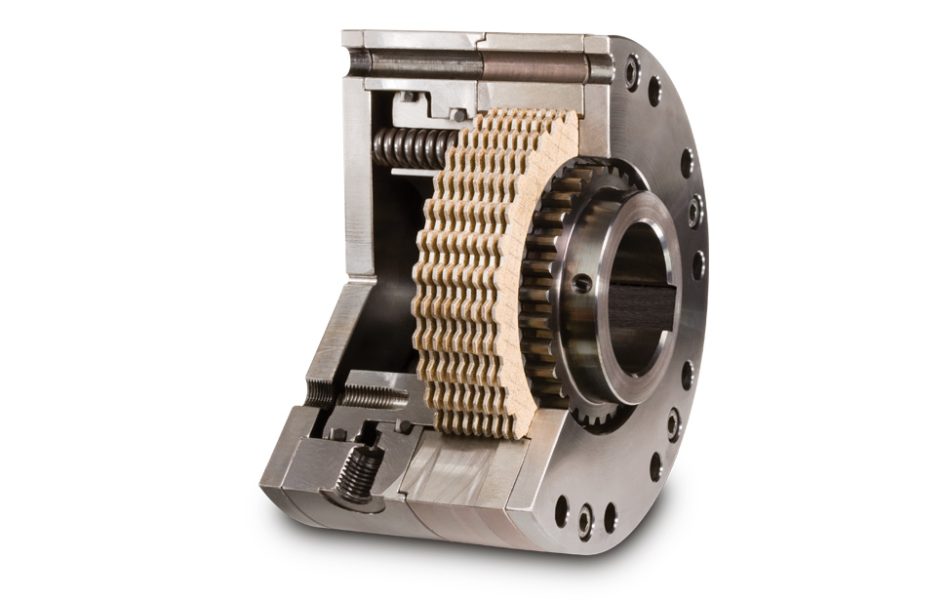
This modification of the couplings allows the radial dimensions of the device to be reduced without sacrificing performance. Here are the key factors that apply to this modification:
- They allow reducing the radial dimensions of the device, but at the same time increasing the productivity of the mechanism;
- Such devices are successfully used in freight transport;
- The number of friction elements allows you to increase the friction force, due to which it is possible to transmit torque of greater power (the device can be of unlimited thickness);
- Such clutches can be dry or wet (with lubricated friction discs).
Single drum types
In this modification, one or more plates are located inside the drum. Downforce is adjusted by spring-loaded pins. Similar mechanisms are still used in some car models, but they are more often found in cranes. The reason for this is the ability to withstand heavy axle loads.
The inclusion plug in the structure is installed near its base. The friction discs are leading, and the driven ones are polished, and can rotate at high speed. The features of these products include:
- Small size;
- Lack of friction or abrasive materials (in most varieties);
- The design allows to reduce heating during the operation of the device;
- If you use a friction analogue, you can increase the torque power.
Types with multiple reels
Often you can find a friction-type safety clutch, the design of which includes several drums. The advantages of this type of device include high downforce, high-quality emphasis, and the ability to cope with heavy loads. In these modifications, overlays are rarely used.
Models with multiple drums use a large pinion gear, while some models use tension pins and a double rack. The connecting plug is located at the front of the device.
These device modifications are not used in the drives, as they have a slow connection. Several manufacturers have developed versions of the multi-drum model that use a release disc. In this design, the stem is horizontal and the fingers are small.
These modifications have great downforce. The drums only rotate in one direction. The drive disc can be located either in front of the release plate or behind it.
Bushings
This modification is only used in clutches. Sometimes they can be installed in the drive train. They use release springs, over which tie pins are installed, and inside there may be several partitions. Each plate of the mechanism is located horizontally, and the bushing is installed between the partitions (in addition, it acts as a damper).
The disadvantage of this modification of the couplings is the weak compression of the discs. Still, strong rotation of the shaft must not be allowed. For these reasons, devices in this category are not used in drives.
Flanged
The advantage of flange couplings is that the drum is not worn out so much in them. The discs are fixed behind the rack. The partitions inside the product are small. So that the rack can be in one place, it is clamped with special plates. Typically, the springs in such couplings are installed at the bottom of the structure. Some modifications can be paired with a drive. The drive shaft is connected to the device with a plug. Sometimes there are options that use a wide squeeze disc. This mechanism is small in size, and the body is made in the form of a cone.
Flange couplings are easier to install and maintain. Such products have a long working life and high reliability. Despite the prevalence of such devices, they are not always installed.
Articulated
This modification of the couplings can be used in drives with different powers. The design of such a mechanism uses a wide partition (there may be notches on it) and short fingers. The discs are fixed at the base of the plates. The body of this type of device can be of different sizes, depending on the dimensions of their elements. Tightening pins are installed in front of the rack.
The power take-off by such a device directly depends on the dimensions of the drum. Often, its wall is wide. Its edges do not come into contact with the discs due to sharpening and the use of hinges.
Cam
Couplings of this type are used in industrial machines. Most modifications are capable of withstanding heavy loads, but this depends on the dimensions of the drum. There are varieties in which the drum is fixed by partitions, and plates may also be present in their design. To keep the parts together, the body is made in the form of a cone.
The most common modifications are with squeeze discs. In this case, the drum will be small. The fork in this model is connected to the rods. Some types of clutches use these types of couplings. Fixation of the tie pins (small parts are used) can take place near the base of the partition. The advantage of these types of couplings is that the driven drum practically does not wear out.
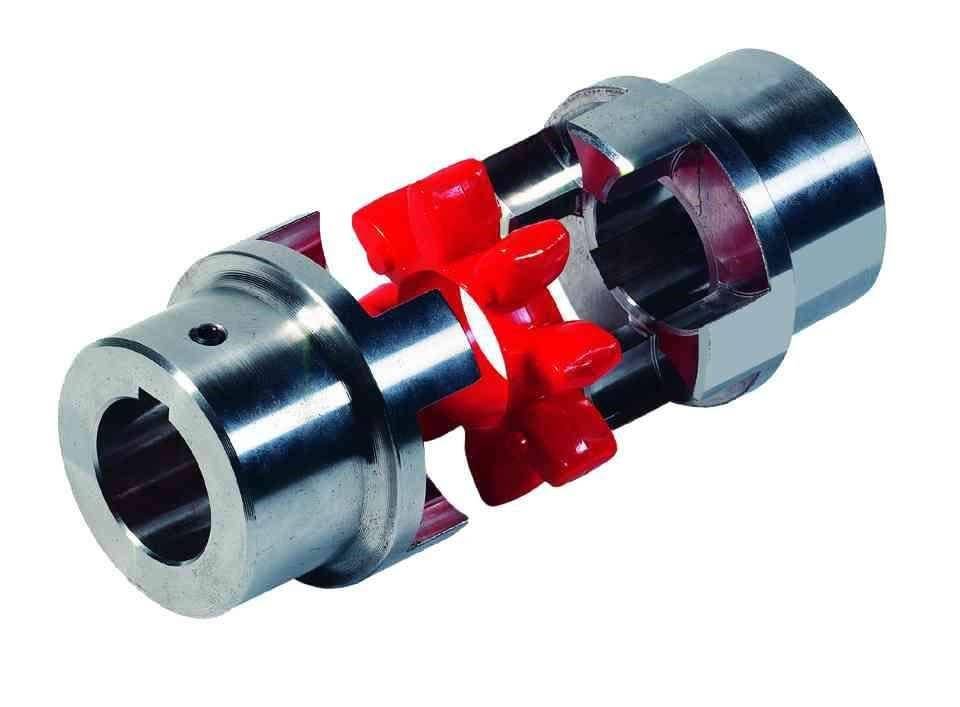
The principle of operation of such a modification is as follows:
- When the drive is triggered, the cams located in one coupling half enter the protrusions of the other coupling half. The connection of the two elements is rigid;
- The working part moves along the axis using a spline connection (instead of a spline, another guide element can also be used);
- The moving part for less wear of the mechanism should be installed on the driven shaft.
There are modifications in which the cams are triangular, trapezoidal and rectangular. The cams are made of hardened steel so that they can withstand heavy loads. In some cases, an asymmetrical profile may be used.
Drive options
For drive mechanisms, such multi-plate clutches are used, in which both one and several drums can be used. In these versions, the stem is suitable for mounting on a small shaft. The drum is positioned horizontally. Many of these couplings use aluminum discs (or their alloys). Also, such mechanisms can be with spring-loaded elements.
In the classic case, the drive clutch has two expanding discs, between which a plate is installed. A bushing is attached behind the rod of the device. To prevent the drum from prematurely wearing out, the design of the mechanism provides for the presence of a bearing.
The models used in high-power installations have a slightly different design. A baffle is installed near the squeezing disk, and the driven drum is fixed on a wide rack. Springs can be equipped with ties. The fork is fixed at the base. The body of some modifications is tapered. The device of mechanisms can include small working plates.
Sleeve-finger
Resilient pin-bush couplings are also common. They are used in the construction of various mechanisms. The features of this modification include the following factors:
- In most cases, these products are manufactured in accordance with certain standards, so that you can easily select the right model for a specific movement;
- When designing this mechanism, you can download several options for detailed drawings from the Internet;
- Different materials can be used depending on the purpose of the coupling.
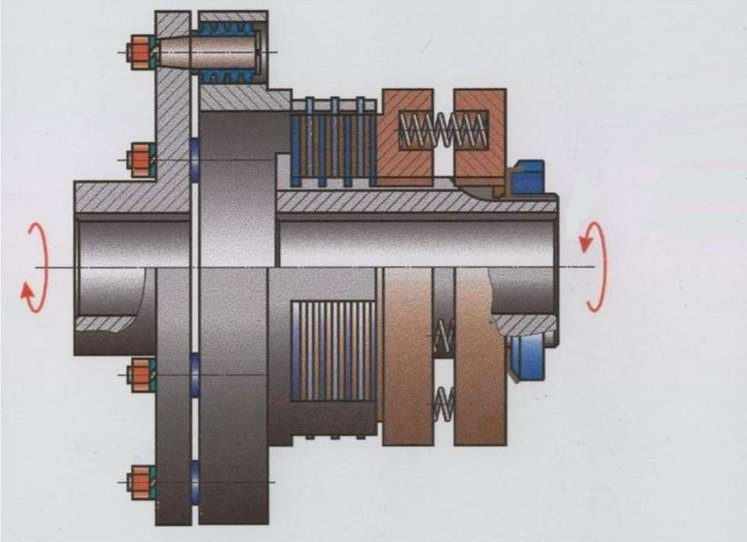
Typically, these types of couplings are used as fuses.
Friction
Friction clutches are used in those mechanisms in which smooth transmission of torque must be ensured, regardless of the rotation speed of the driving and driven shafts. Also, this modification is capable of operating under load. The peculiarity of the efficiency of the mechanism lies in the high frictional force, which ensures the maximum possible power take-off.
The features of friction clutches include the following factors:
- No shock loads, since engagement occurs smoothly with slippage during the connection of the discs. This is the key benefit of this modification;
- Due to the strong pressure of the discs between them, slip is reduced, and the frictional force increases. This leads to an increase in torque on the driven unit to the extent that the revolutions of the shafts become the same;
- The speed of rotation of the driven shaft can be adjusted using the force of compression of the discs.
Despite these advantages, friction clutches also have significant disadvantages. One of them is the increased wear of the friction surfaces of the contact discs. In addition, as the frictional force increases, the discs can become very hot.
Advantages and disadvantages
The advantages of multi-plate clutches include:
- Compact design dimensions;
- The unit itself, in which such a coupling is used, will also be smaller;
- To increase the torque, there is no need to install a huge disc. For this, manufacturers use an oversized design with multiple discs. Thanks to this, with a modest size, the device is capable of transmitting a decent indicator of torque;
- Power is supplied to the drive shaft smoothly, without jerking;
- It is possible to connect two shafts in the same plane (coaxial connection).
But this device also has some disadvantages. The weakest point in this design is the friction surfaces of the discs, which wear out over time from natural processes. But if the driver has a habit of sharply pressing the gas pedal when accelerating the car or on an unstable surface, then the clutch (if the transmission is equipped with it) will wear out faster.

With regard to wet types of clutches, the viscosity of the oil directly affects the force of friction between the discs - the thicker the lubricant, the worse the adhesion. For this reason, in mechanisms equipped with multi-plate clutches, it is necessary to change the oil in a timely manner.
Coupling application
Multi-plate clutches can be used in different vehicle systems. Here are the mechanisms and units that can be equipped with this device:
- In the clutch baskets (these are variator modifications in which there is no torque converter);
- Automatic transmission - in this unit, the clutch will transmit torque to the planetary gear;
- In robotic gearboxes. Although not a classic multi-plate clutch is used here, a double dry or wet clutch works on the same principle (for more information on preselective gearboxes, read in another article);
- In all-wheel drive systems. The multi-plate clutch is installed in the transfer case. In this case, the mechanism is used as an analogue of blocking the center differential (for details on why blocking of this device may be required, read separately). In this arrangement, the automatic mode of connecting the secondary axle will be softer than in the case of a classic differential lock;
- In some modifications of differentials. If a multi-plate clutch is used in such a mechanism, then it provides complete or partial blocking of the device.
So, despite the fact that classical mechanisms are gradually being replaced by hydraulic, electrical or pneumatic analogs, in many systems it is not yet possible to completely exclude the presence of parts that work on the basis of physical laws, for example, the friction force. The multi-plate friction clutch is proof of this. Due to its simplicity of design, it is still in demand in many units, and sometimes replaces more complex devices.
Despite the fact that these elements are constantly in need of repair or replacement, manufacturers cannot completely replace them with more efficient ones. The only thing that the engineers did was to develop other materials that provide greater wear resistance of the products.
At the end of the review, we offer a short video about friction clutches:
Repair of friction clutches
Depending on the modification and purpose of the friction clutch, it can be repaired rather than buying a new one. If the manufacturer of the device has provided for such a possibility, then first of all it is necessary to remove the worn out friction layer. It can be fixed to the substrate using rivets or epoxies. After dismantling, the surface of the base must be well cleaned of glue residues or sanded if there are burrs on it.
Since the wear of the friction material occurs due to the slipping of the connection with great effort, it would be much more practical not to install a new lining using rivets, but to connect it to the metal base of the coupling with epoxy materials intended for operation at high temperatures.
If you fasten the friction material with rivets, as this layer wears out, the rivets can cling to the metal working surface of the connected disc, which will render it unusable. For reliable fixation of the friction layer on the base, you can use VS-UT glue. This adhesive is composed of synthetic resins dissolved in organic solvents.
A film of this adhesive provides a secure adhesion of the friction material to the metal. The film is refractory, not subject to destruction due to exposure to water, low temperatures and oil products.
After repairing the clutch, you need to make sure that the friction layer will be in full contact with the working surface of the metal disc. For this, red lead is used - an orange paint. The contact point must fully correspond to the area of the clutch friction element. If, during operation, a poor-quality or damaged friction element damaged the surface of the pressure disk (scratches, burrs, etc. appeared), in addition to repairing the friction pad, the working surface must also be sanded. Otherwise, the friction lining will wear out quickly.
Questions and answers:
What is a friction clutch for? Such an element ensures the adhesion of two mechanisms by means of discs with a friction and smooth surface. A classic example of such a connection is the clutch basket.
How does a disc clutch work? The drive shaft with the main disc rotates, the driven discs / disc are pressed against it by a powerful spring. The friction surface, due to the frictional force, provides the transfer of torque from the disc to the gearbox.
What happens when the friction clutch engages? When the friction clutch engages, it absorbs mechanical energy (torque) and transfers it to the next part of the mechanism. This releases heat energy.
What is a multi-plate friction clutch? This is a modification of the mechanism, the purpose of which is to transmit torque. The mechanism consists of a pack of discs (one group is steel, and the other is frictional), which are tightly pressed against each other.

